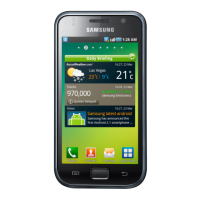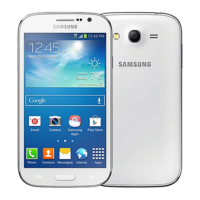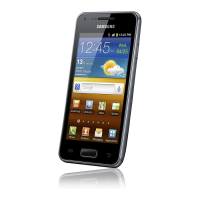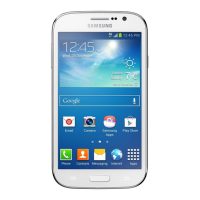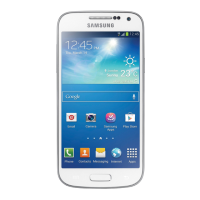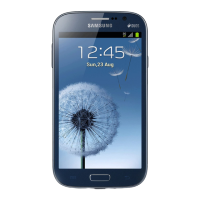
Do you have a question about the Samsung GT-I9082 and is the answer not in the manual?
| Model | GT-I9082 |
|---|---|
| Announced | 2013, January |
| Status | Discontinued |
| Network | GSM / HSPA |
| 2G bands | GSM 850 / 900 / 1800 / 1900 - SIM 1 & SIM 2 |
| 3G bands | HSDPA 900 / 2100 |
| Speed | HSPA 21.1/5.76 Mbps |
| GPRS | Yes |
| EDGE | Yes |
| Dimensions | 143.5 x 76.9 x 9.6 mm (5.65 x 3.03 x 0.38 in) |
| Weight | 162 g (5.71 oz) |
| SIM | Dual SIM (Mini-SIM, dual stand-by) |
| Display Type | TFT capacitive touchscreen, 16M colors |
| Multitouch | Yes |
| OS | Android 4.1.2 (Jelly Bean), upgradable to 4.2.2 (Jelly Bean) |
| Chipset | Broadcom BCM28155 |
| CPU | Dual-core 1.2 GHz Cortex-A9 |
| GPU | Broadcom VideoCore IV |
| Internal storage | 8GB |
| RAM | 1GB |
| Card slot | microSD, up to 64 GB (dedicated slot) |
| Main Camera | 8 MP, AF |
| Front Camera | 2 MP |
| Video | 1080p@30fps |
| Battery | Removable Li-Ion 2100 mAh battery |
| WLAN | Wi-Fi 802.11 a/b/g/n, dual-band, Wi-Fi Direct, hotspot |
| GPS | Yes, with A-GPS, GLONASS |
| USB | microUSB 2.0 |
| Sensors | Accelerometer, proximity, compass |
| Display Size | 5.0 inches |
| Resolution | 480 x 800 pixels (~187 ppi pixel density) |
| Bluetooth | 4.0, A2DP |
| Radio | FM radio, RDS |
| Colors | White |
Details the physical components and layout of the device.
Explains the function of each physical button on the device.
Lists the items included in the product box.
Step-by-step guide for inserting SIM/USIM cards and the battery.
Instructions for safely removing the SIM/USIM cards and battery.
Instructions on how to charge the device's battery.
Tips and settings to conserve battery life.
Guide to inserting and using a memory card.
Steps for safely removing the memory card from the device.
How to format a memory card for the device.
Instructions for powering the device on and off.
Guidance on how to hold the device properly.
Methods to lock and unlock the device screen.
How to control the device's audio volume.
How to put the device into silent or vibrate mode.
Managing dual SIM card network connections.
Explains the meaning of icons displayed on the status bar.
General guidelines and precautions for using the touch screen interface.
How to interact with the screen by tapping.
How to move items on the screen by dragging.
How to zoom or navigate by double-tapping the screen.
How to scroll or switch panels by flicking.
How to zoom in/out by pinching the screen.
Using device movements for control.
How the screen orientation changes automatically.
Device behavior when picked up after idle.
Using the device to make calls by holding it to the ear.
Moving items between screen panels.
Browsing zoomed images by panning.
Navigating lists by double-tapping the device.
Launching camera by rotating device while screen is locked.
Muting or pausing by turning the device over.
Using shaking gestures for specific functions.
Capturing screenshots by sweeping hand across screen.
Pausing media playback by covering the screen.
Zooming in/out by tilting the device.
Feature that launches apps based on user actions.
Enabling the feature to run two apps simultaneously.
How to manage and use the Multi Window interface.
Managing status bar icons and notification panel features.
Overview of the device's home screen and panels.
Adding, moving, and removing items on the home screen.
Adding, moving, and removing home screen panels.
How to set images as the device wallpaper.
How to open and close applications on the device.
Accessing and navigating the list of all installed applications.
Organizing application icons on the screen.
Grouping applications into folders for convenience.
Downloading and installing new applications.
Removing applications from the device.
Sharing applications with others.
Accessing help information and tips.
Methods for inputting text on the device.
Selecting different keyboard layouts.
Customizing the Samsung keyboard features.
Using handwriting for text input.
Using voice input for text entry.
How to copy and paste text on the device.
Steps to connect the device to a Wi-Fi network.
How to enable or disable the Wi-Fi feature.
Selecting and connecting to available Wi-Fi networks.
Creating and managing Google and Samsung accounts.
Moving files between the device and a computer.
Using Samsung Kies for device management and file transfer.
Syncing media files using Windows Media Player.
Using the device as a media storage device (MTP/PTP).
Using security features to protect the device.
Setting a screen lock pattern for security.
Setting a PIN for screen lock.
Setting a password for screen lock.
Procedures to unlock the device using the set code.
How to update the device software.
Updating device software wirelessly via FOTA.
Using the phone application to make and receive calls.
Various methods to initiate phone calls.
Searching for contacts in the address book.
Actions available while on a phone call.
Adding new contacts to the address book.
Accessing the history of incoming and outgoing calls.
Setting up call barring to restrict calls.
How to answer an incoming phone call.
Methods to decline incoming calls.
Managing calls when another call is incoming.
Setting up call forwarding to a specified number.
How to terminate a phone call.
Making and conducting video calls.
Actions available during a video call.
Managing contact information on the device.
Adding new entries to the contacts list.
Modifying existing contact details.
Removing contacts from the list.
Finding contacts using various search methods.
Managing contacts by importing and exporting.
Synchronizing contacts with Google account.
Synchronizing contacts with Samsung account.
Managing and accessing favourite contacts.
Organizing contacts into groups.
Sending and receiving SMS and MMS messages.
Composing and sending text or multimedia messages.
Sending and viewing email messages.
Configuring email accounts on the device.
Accessing and reading incoming email messages.
Using the Google Mail application.
Composing and sending emails in Google Mail.
Using Google Talk for instant messaging.
Adding contacts to the Google Talk friends list.
Staying connected via Google's social network.
Instant messaging via Google+.
A chat application for mobile devices.
Browsing the internet using the device.
Navigating and interacting with web pages.
Saving and accessing favorite web pages.
Viewing and clearing browsing history.
Using the Chrome browser for web searching.
Connecting wirelessly with other devices via Bluetooth.
Connecting and pairing Bluetooth devices.
Playing and sharing content across devices.
Sharing screens with multiple devices over Wi-Fi.
Sharing media content with other devices via Group Play.
Listening to music on the device.
Selecting and playing music tracks.
Making custom song playlists.
Taking photos and videos with the device camera.
Instructions for taking still photographs.
Selecting camera scene modes for optimal shots.
Various modes for capturing photos.
Creating wide landscape photos by stitching shots.
Instructions for recording video clips.
Adjusting zoom levels while recording video or taking photos.
Viewing photos and videos stored on the device.
Navigating and viewing images in the Gallery app.
Using motion gestures for image viewing.
Watching video files on the device.
Basic image editing functions.
Removing unwanted images from the device.
Sending images to others or social networks.
Playing video files on the device.
Selecting and watching video clips.
Watching videos from the YouTube platform.
Listening to FM radio broadcasts.
Accessing personalized digital magazines.
Downloading and purchasing apps from Google Play.
Downloading dedicated Samsung applications.
Discovering and downloading recommended Samsung apps.
Accessing and downloading games.
Purchasing and downloading music.
Reading and downloading e-books.
Watching, downloading, and renting movies/TV shows.
Accessing and purchasing video content.
Creating memos with text, images, and voice recordings.
Features and tools for creating memos.
Searching, sorting, and viewing existing memos.
Managing events and tasks on the device.
Adding new events or tasks to the planner.
Synchronizing calendar data with Google Calendar.
Setting alarms, checking time, and using timers.
Setting and managing alarms.
Checking time in different cities worldwide.
Using the stopwatch function.
Performing calculations with the device.
Saving and sharing files using Dropbox cloud storage.
Recording and playing voice memos.
Steps for recording voice memos.
Using voice commands to control the device.
Searching the internet and device contents.
Viewing personalized information cards.
Searching the web using voice commands.
Accessing and managing device files.
Viewing files downloaded from applications.
Pinpointing locations and getting directions.
Finding places and viewing location details.
Steps to obtain driving or walking directions.
Searching for nearby points of interest.
Finding routes to destinations.
Configuring device and application settings.
Connecting to Wi-Fi networks.
Managing Bluetooth connections and data exchange.
Monitoring and managing mobile data consumption.
Configuring mobile network settings.
Sharing the device's internet connection.
Managing SIM card settings.
Adjusting device sound and ringtone settings.
Customizing display settings like wallpaper and brightness.
Viewing memory information and formatting storage.
Activating and configuring power saving options.
Viewing and managing installed applications.
Configuring GPS and location settings.
Setting up screen lock features.
Enhancing device security with passwords and encryption.
Managing remote controls, SIM lock, and trusted credentials.
Changing device language and text input methods.
Selecting a voice recognition engine.
Using voice commands for searching.
Configuring cloud syncing for data.
Backing up and resetting device data and settings.
Activating and configuring motion-based controls.
Adjusting settings for connected accessories.
Setting and managing the device's date and time.
Special features for users with physical disabilities.
Advanced settings for application development.
Entering device lock codes when prompted.
Resolving issues related to network connectivity.
Troubleshooting touch screen responsiveness issues.
Steps to resolve device freezing or fatal errors.
Addressing issues with dropped calls due to poor signal.
Resolving issues with poor audio quality during calls.
Troubleshooting battery charging and power issues.
Resolving camera app launch errors.
Troubleshooting issues with playing music files.
Troubleshooting issues finding Bluetooth devices.
Resolving computer connection problems.
